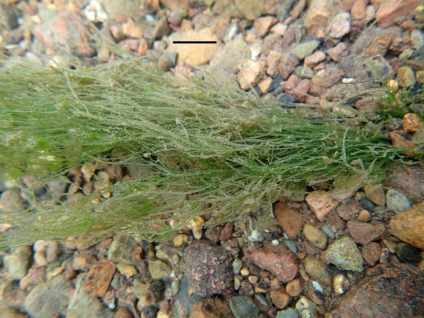I noticed some patches of a small, bright-green plant fully submerged in the slack waters beside the River Ehen a kilometre or so below the outflow from Ennerdale Water. My first look suggested a tangle of narrow, flaccid grass-like stems but a closer examination showed that each of the narrow stems had whorls of branches arising from them at intervals (similar to the pattern seen in horsetails). Their size and structure suggested an affinity to the vascular plants such as Myriophyllum and Juncus that I also saw in the river that day but, actually, these plants belong to an algal genus called Nitella. I could not see any reproductive organs on these plants, but other evidence points to them being Nitella flexilis.
Nitella belongs to a group of algae called the Charophytes which have been the subject of vigorous debate by phycologists and evoloutionary scientists for a long time. The author of one recent paper went so far as to claim that “no group in the plant kingdom has presented greater difficulties in classification …”. They are usually placed in the green algae (Chlorophyta) although some people regard them as a separate division entirely. Charophytes, in fact, have several characteristics, as well as their size and pigmentation, that suggest that they may be the closest algal relatives of land plants. These similarities extend to the reproductive organs (see Chris Carter’s image of Chara virgata in a post from July last year).
Nitella flexilis photographed in the River Ehen, 18 March 2014. Scale bar: 1 centimetre.
Under the microscope, some oddities of Nitella and other charophytes become clear. The branchlets , despite their size, are composed of single giant cells, each with many tiny chloroplasts around the margins and a large central vacuole. If you watch closely, you can see the cytoplasm close to the vacuole within these cells streaming around (though this proved to be hard to capture on video). These giant cells made the charophytes very popular with physiologists, as they were easy to manipulate in the laboratory.
A cell of a branchlet of Nitella flexilis from the River Ehen collected on 18 March 2014. Scale bar: 1/10th of a millimetre.
Their large size and distinctive appearance has meant that Charophytes were often recorded by mainstream botanists who usually ignore algae completely. This means that we have a better understanding of their distribution than is the case for most freshwater algae. These show records of Nitella flexilis and relatives to be particularly clustered around the Lake District and other areas associated with soft water, though more often in ponds and lakes than in rivers. It is certainly not a common genus so this is one more feature that makes the River Ehen such a fascinating river to study.
References
Bennici, A. (2008). Origin and early evolution of land plants. Problems and considerations. Communicative and Integrative Biology 1: 212-218.
Karol, K.G., McCourt, R.M., Cimino, M.T. & Delwiche, C.E. (2001). The closest living relatives of land plants. Science (New York) 294: 2351-2353.
Ruhfel, B.R., Gitzendanner, M.A., Soltis, P.S., Soltis, D.E. & Burleigh, J.G. (2014). From algae to angiosperms – inferring the phylogeny of green plants (Viridiplantae) from 360 plastid genomes. BMC Evolutionary Biology 14: 23.



Pingback: More about Croft Kettle | microscopesandmonsters
Pingback: ‘Signal’ or ‘noise’? | microscopesandmonsters
Pingback: Life in the deep zone … – microscopesandmonsters